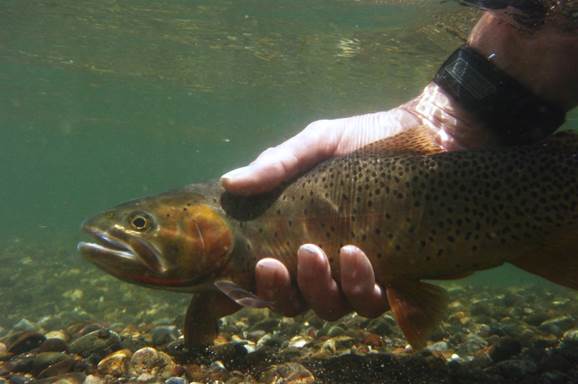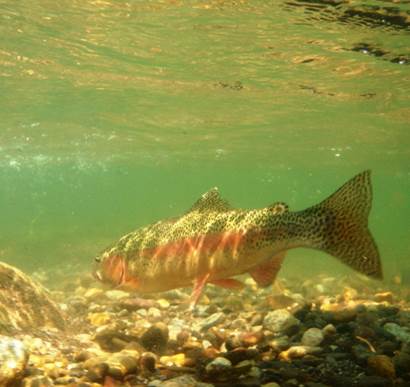NATIVES

Cutthroat trout from Soda Butte, Yellowstone National Park
Definitions:
Native – born or originating in a particular place [Encarta Dictionary]
For the last several years it has become a cultural vogue in the fisheries departments across this country to eliminate so called "non-native" species in favor of historically native species. This policy has resulted in viable populations of fish being totally eradicated in favor of a species that were historically present.
Recently, in Yellowstone National Park, this policy was instituted in the Lamar and Slough Creek drainages in an attempt to eradicate rainbow trout and brook trout – which are really not trout but char. Now it's important to remember that both of these species were stocked in these drainages, not by "bucket biologists" but by officials of the agencies that managed the Park. These fish were stocked in these drainages to enhance the existing stock of fish that existed in these streams, and in some instances to establish a population of fish where, historically, no fish existed.
The rainbows and brook trout [char] that are currently found in the various waters of Yellowstone National Park have been swimming and breeding in most of those waters for over 100 years. According to the Yellowstone National Park archives the first fish from outside of the Park were stocked in 1889-1890. They included brook trout [char], rainbow trout, brown trout, and lake trout. Between 1881 and 1955 when the stocking program was phased out the Park Service planted more than 310 million fish native and non-native fish. It is interesting to note that land-locked Atlantic salmon were introduced into Yellowstone Lake in 1908. Bass [they are uncertain if they were largemouth or smallmouth] were planted in 1893 in the Gibbon River and in the early 1900s Largemouth bass were introduced in two lakes in the Lower Geyser Basin.

Rainbow or cuttbow?
Now it seems that if those fish that survived and established viable populations are natives. While it's true that they were not present when the Park was established several species of animals and many species of plants were not present when the Park was established. They are now considered a normal part of scene. The iconic bison only frequented the high country of Yellowstone in the summer months. Likewise elk, pronghorn and even the grizzly bear were mostly plains animals before they were pushed into areas like Yellowstone by the western expansion of white settlers.
Even man is a 'non-native' species in Yellowstone. The harsh climate of Yellowstone and the geysers and other thermal features caused most Native American tribes to avoid the Yellowstone area. Only one tribe of Native Americans lived in the Yellowstone area, a band of Mountain Shoshones, called Sheep Eaters, lived within the confines of what is today Yellowstone National Park. These hunter/gatherers lived in the high mountain areas of the northern Rockies in the area of modern day Montana and Wyoming and adapted to the harsh climate. In addition, even the "Native Americans" are not truly native since they did not originate in the Western Hemisphere, but migrated here from the European continent. Like all humanoids we are aliens in North and South America.
I think that I could successful argue in a court of law that I'm a "native American' since I was born in the United States and my parents were also born in the United States. In fact, I can trace my lineage, on my father's side of the family, back to just after the Revolutionary War. Fish that were introduced into the various places around our country before most of us were born are certainly natives. The fact that they, like everyone living in the Northern Hemisphere, came from someplace else at some time in the distance past does not make them aliens.
One of the often overlooked realities is that all of creation is in a constant state of flux, and we do not have a magic wand that will allow us to return to some previous time. Yellowstone National Park is nothing like the Yellowstone area that was familiar to the roaming bands of Plains Indians or the first fur trappers that pushed through the area. The rainbow, brook, lake and brown trout that swim in many Park waters represent a success story from the perspective of natural history. The trout species that have, in some cases, replaced the previous species provide the same biological benefits that the previous species provided. They provide food for the fish eating species and are no more or less nutritious than the fish they have replaced. To destroy a successful population of fish in an attempt to restore a "native" population of fish makes little sense, and could potentially result in a less productive fishery than the one they replaced.
Today we are trying to turn back the clock, but I think that it's important to remember that attempting to manipulate established biological systems gave the perceived problem that we are now trying to correct. Perhaps it would be better if we simply left well enough alone and managed the resource that we have rather than attempt to recreate a resource that may or may not be successful.
